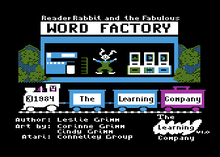| Reader Rabbit | |
|---|---|
 | |
| Developer(s) | The Learning Company The Connelley Group (Atari 8-bit) |
| Publisher(s) | The Learning Company |
| Series | Reader Rabbit |
| Platform(s) | Original Apple II, Apple IIGS, Atari 8-bit, Commodore 64, MS-DOS, Mac Talking Windows, Mac |
| Release | 1984 (Original) 1989 (Talking) 1991 (Reader Rabbit 1) 1994 (Deluxe) 1997 (Reading 1) |
| Genre(s) | Educational |
| Mode(s) | Single-player |
Reader Rabbit (fully titled "Reader Rabbit and the Fabulous Word Factory" or alternatively known as "Reader Rabbit Builds Early Learning & Thinking") is a 1984 educational video game and the first of the long-running Reader Rabbit edutainment series. It was made by The Learning Company for Apple II and later for other computers. It supports the KoalaPad graphics tablet. The Connelley Group helped with the Atari 8-bit computers conversion in 1984. A Talking version was developed for the Apple IIGS in 1989. An enhanced version was released for MS-DOS -n 1991. A Deluxe version was released in 1994 for Mac and Windows 3.x. In 1997, the game was remade for Windows and Macintosh under the title "Reader Rabbit's Reading 1".
Gameplay
The game takes place in the titular Word Factory, which teaches reading and spelling in four different activities and has over 200 three-letter words and more than 70 pictures for learning. The following four activities are:
- 1. Sorter - the player is required to pick words that start with a chosen letter and discard the rest.
- 2. Labeler - out of a number of mixed up letters, the player must use those letters to spell words that match three objects on the screen.
- 3. Word Train - the player needs to select a word that slightly differs from the first.
- 4. Matchup Games - the player must match picture cards with corresponding word cards.
Development

Reader Rabbit was originally conceived by the Grimm sisters; Leslie authored the game while Corinne and Cindy contributed the art. Version 1.0 of Reader Rabbit, titled Reader Rabbit and the Fabulous Word Factory, was released in early 1984 (and featured in the 1983 holiday special for Computer Chronicles), while versions 1.1, 1.2 and 1.3 were released in 1984. Development for an updated 2.0 version began at the start of 1984. By this time, Leslie Grimm had suffered a disc fracture but was able to develop the game while bedridden, thanks to a detachable keyboard provided by her colleague Pete Rowe. Many critics and gaming historians erroneously assert that the Reader Rabbit series officially began in 1986.
In 1988, the first "talking" version of Reader Rabbit was released for the Apple IIGS and Tandy 1000 computers. The game was remade as an enhanced version for DOS in 1991 to incorporate the 256-color VGA mode, sound card option and mouse compatibility. Another remake was done as a deluxe version along with its two sequels and implemented digitized speech.
Reception
Reception| Publication | Award |
|---|---|
| Newsweek | Editors' Choice Award, 1995 (Deluxe) |
| Gold Medal | National Association of Parenting Publications, 1994 (Deluxe) |
| Reseller Management | "Best to Sell" Software Product - Education, 1992 (Reader Rabbit 1) |
| Program of the Decade | Language Arts, Technology & Learning, 1991 (Reader Rabbit 1) |
| Parents' Choice | Best Software of the Year, 1987 (Original) |
| Family Computing | Critics' Choice Award, 1985 (Original) |
The Learning Company showcased the game alongside Number Stamper, Word Spinner, Addition Magician and Colorasaurus in the 1984 Winter Consumer Electronics Show. Dr. Ann Piestrup praised the game for its ability to aid young learners in overcoming the difficulties of reading and its word recognition.
References
- ^ "Atari Mania - Reader Rabbit". Retrieved March 5, 2017.
- ^ Brett Alan Weiss. "Reader Rabbit - Review - allgame". Allgame. Archived from the original on November 15, 2014. Retrieved March 5, 2017.
- "Reader Rabbit and the Fabulous Word Factory" Manual. The Learning Company. 1984. p. 11. Retrieved March 5, 2017.
- ^ Staples, Betsy (April 1984). "Getting educated at CES; educational software crowds the show floor". Creative Computing. Vol. 10, no. 4. Ziff Davis. p. 154.
- Leslie Grimm (1984-01-01), Reader Rabbit 1.1, The Learning Company, retrieved 2017-02-06
- Bradley, Laura (2014-11-28). "Tech Time Capsule". Slate. ISSN 1091-2339. Retrieved 2017-02-06.
- Mace, Scott; Caruso, Denise (February 13, 1984). "TLC shows off additions to firm's educational line". InfoWorld. InfoWorld Media Group, Inc. p. 40.
- Reader Rabbit 1.3 (4am crack), 2015-07-14, retrieved 2017-02-06
- "Softalk, Volume 4". Softalk. January 1984. p. 65. Retrieved February 2, 2017.
- "10 Educational PC Games of the 1980s". PCMAG. Archived from the original on 2017-02-07. Retrieved 2017-02-15.
- "Educational software now receiving higher marks". 1988-01-10. Archived from the original on 2017-02-07.
{{cite journal}}: Cite journal requires|journal=(help) - "Reader Rabbit Redux". PCMAG. 31 December 1991. Retrieved 2018-01-31.
- "Reader Rabbit 1 Features". The Learning Company. Archived from the original on February 25, 1997. Retrieved February 1, 2018.
{{cite web}}: CS1 maint: bot: original URL status unknown (link) - ^ "Reader Rabbit 1 Awards". The Learning Company. Archived from the original on February 25, 1997. Retrieved February 1, 2018.
{{cite web}}: CS1 maint: bot: original URL status unknown (link) - Mace, Scott; Caruso, Denise (February 13, 1984). "TLC shows off additions to firm's educational line". InfoWorld. No. 13. IDG. p. 40.
External links
Categories:- 1984 video games
- 1990 video games
- 1991 video games
- 1994 video games
- 1997 video games
- Apple II games
- Apple IIGS games
- Atari 8-bit computer games
- Children's educational video games
- Classic Mac OS games
- Commodore 64 games
- DOS games
- The Learning Company games
- Reader Rabbit
- Single-player video games
- Video games about rabbits and hares
- Video games developed in the United States
- Windows games